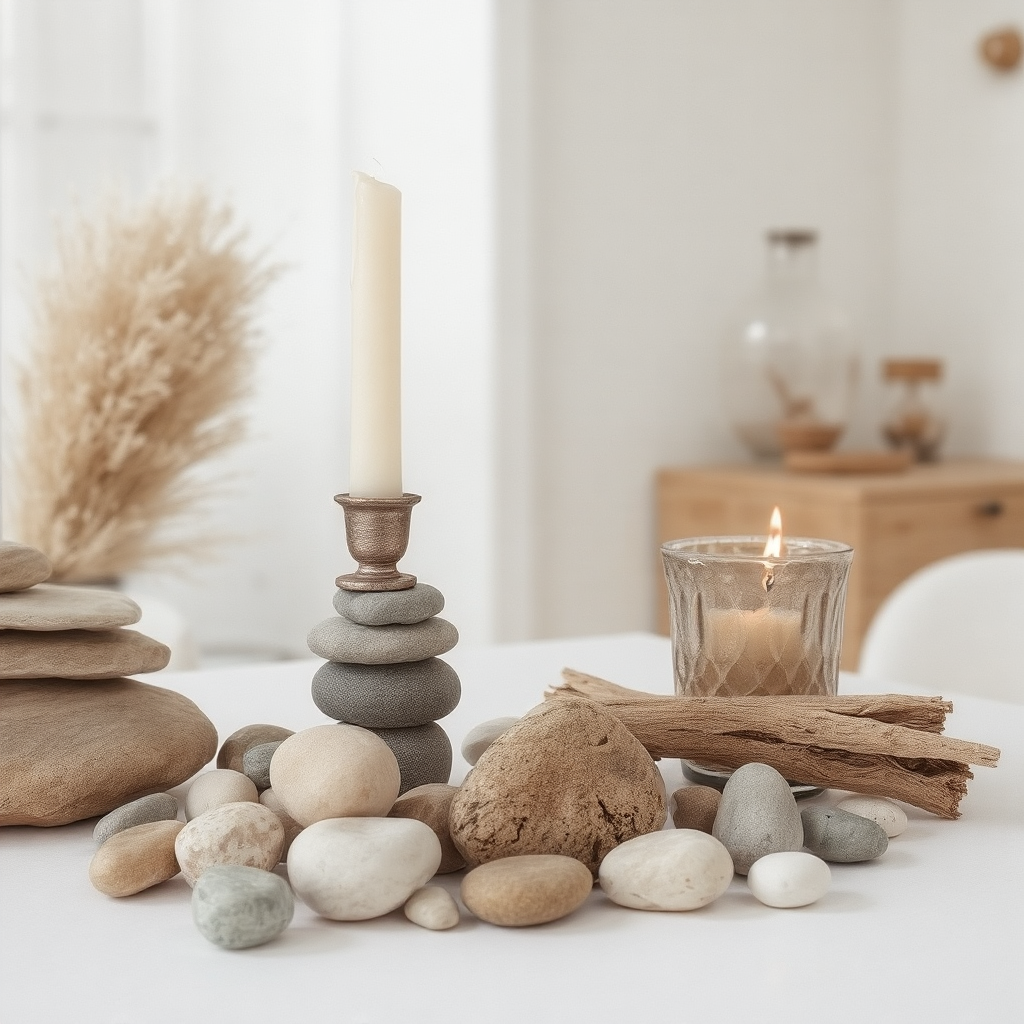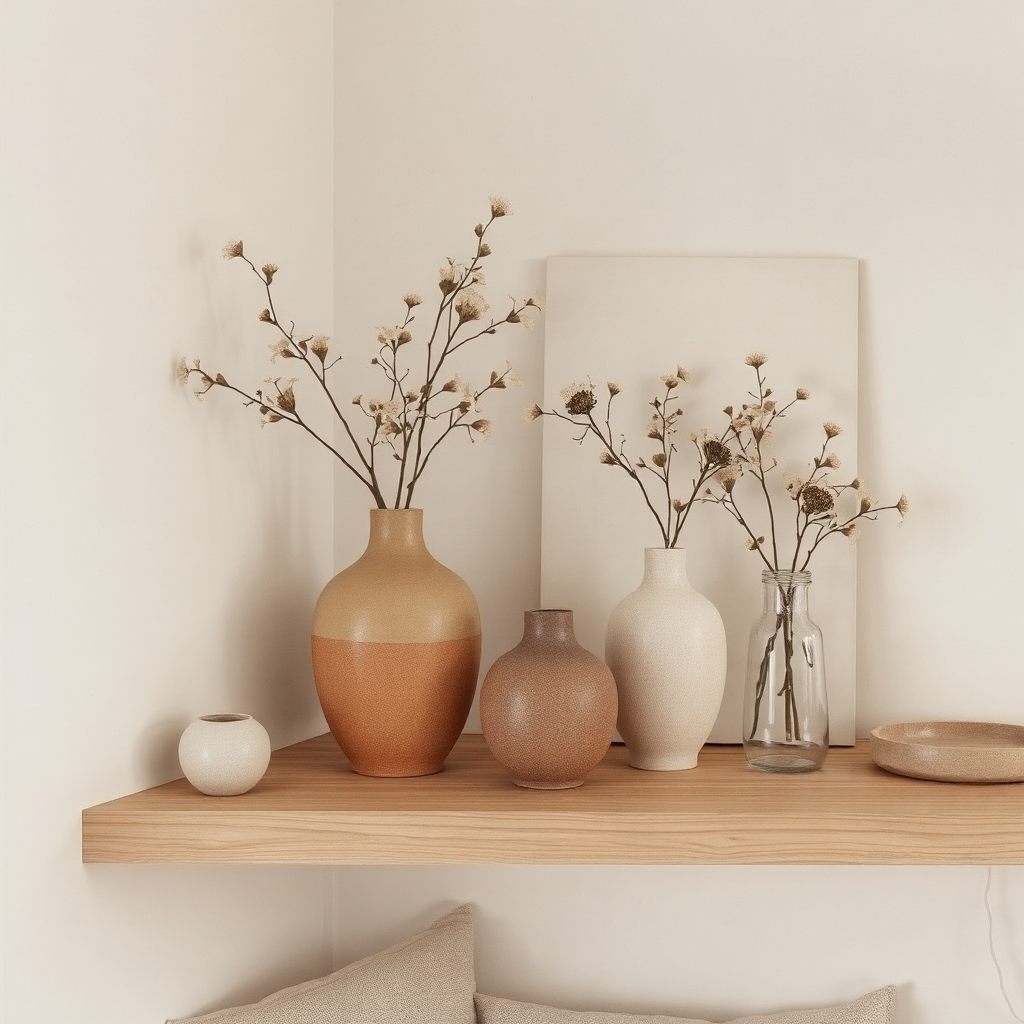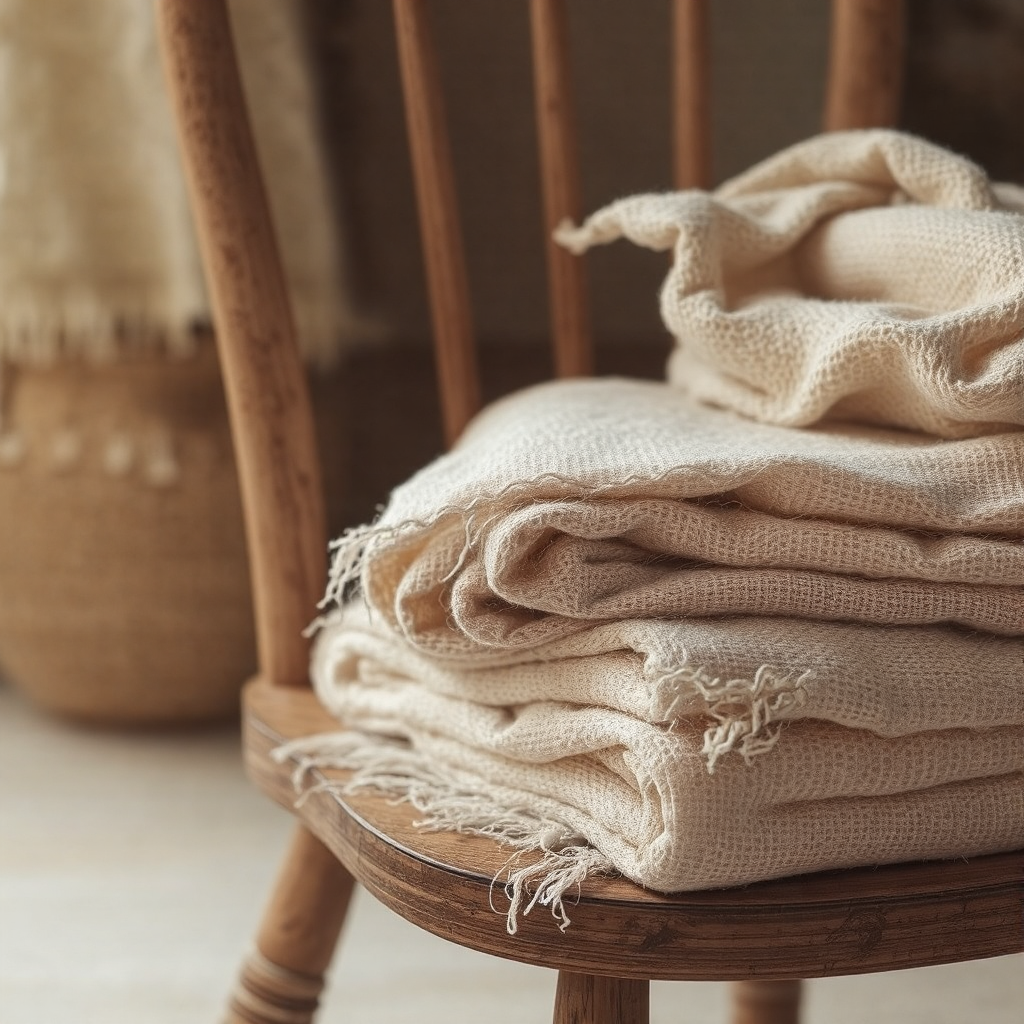Introduction to Natural Decor
The concept of natural decor encompasses the integration of organic elements and materials into interior design, creating a warm and inviting atmosphere that resonates with tranquility. This approach emphasizes the use of items derived from nature, which can range from wooden furniture to stone accents, plant life, and textiles made from natural fibers. By incorporating these elements, homeowners can foster a space that not only looks aesthetically pleasing but also enhances their overall well-being.
One of the primary benefits of utilizing natural decor is its ability to establish a connection to nature. In an increasingly urbanized world, where many individuals spend their days surrounded by concrete and artificial materials, bringing in organic elements serves as a reminder of the beauty and serenity found in the natural environment. Utilizing elements such as houseplants, wicker baskets, and jute rugs can transform a space into a soothing haven, promoting relaxation and comfort within the home.
Moreover, natural decor embodies sustainability by encouraging the use of eco-friendly materials. This kind of decor style often highlights craftsmanship, artistry, and tradition, showcasing items that are made from responsibly sourced materials. In doing so, homeowners can express their values and commitment to environmental conservation while simultaneously crafting spaces that reflect their personal style. Natural decor promotes a balanced aesthetic, blending textures, colors, and shapes inspired by the natural world, allowing for a harmonious and cohesive design.
As we delve deeper into the realm of natural decor, we will explore practical ideas that can be easily implemented in various spaces. From selecting the right color palette to determining how to incorporate botanical elements, next sections will guide readers through the art of creating inviting and serene environments using natural elements.
Incorporating Organic Materials
In the realm of interior decor, the use of organic materials has gained prominence due to their inherent qualities and the aesthetic appeal they offer. Among the most favored organic materials are wood, stone, ceramics, and glass. Each of these materials presents unique advantages, making them suitable choices for a variety of decor styles, from rustic to contemporary.
Wood is a timeless option, renowned for its durability and natural beauty. Whether utilized in furniture, flooring, or decorative accents, wood adds a sense of warmth and character to any space. Consider pieces such as reclaimed wood tables, which not only showcase unique grain patterns but also embody sustainability through their sourcing. The simplicity of wood can harmonize with various color schemes, enhancing the overall ambiance of a room.
Stone, another organic element, brings a sense of permanence and strength to decor. Natural stone surfaces, such as granite or marble, are often used in countertops and flooring, providing not only aesthetic sophistication but also long-lasting resilience. Decorative stone pieces, like slate coasters or limestone sculptures, can also introduce an earthy touch, seamlessly blending with other design elements.
Ceramics offer versatility in both form and function, making them a popular choice for decor items. Handcrafted ceramic vases and bowls add artistic flair to interiors, while their glazed finishes can create visual interest through color and texture. The tactile quality of ceramics can bring depth and warmth to any space, enhancing the sensory experience.
Lastly, glass serves as a perfect complement to organic materials, offering transparency and lightness. From decorative jars to elegant lighting fixtures, glass elements can brighten and elevate the decor without overshadowing other materials. The interplay between organic textures and glass can create a harmonious balance, inviting an atmosphere of serenity.
Incorporating these organic materials into everyday decor not only emphasizes their durability and aesthetic appeal but also invites nature into our living spaces, fostering an environment that feels both inviting and warm.
Embracing Earthy Color Palettes
Color plays a crucial role in natural decor, providing emotional resonance and visual harmony within living spaces. Earthy tones such as greens, browns, and neutrals draw inspiration from the natural world, evoking a sense of calm and serenity reminiscent of forests and landscapes. When creating a natural decor scheme, the thoughtful selection of a color palette is essential, as it can beautifully complement various natural materials like wood, stone, and linen.
To begin curating an earthy color palette, consider starting with shades of green, which can range from soft sage to deeper forest hues. These greens can provide a refreshing backdrop while imbuing a space with vitality. When paired with the warm tones of brown—such as chestnut, taupe, or rust—this combination can create an inviting atmosphere. Neutral tones like beige, cream, or soft gray can serve as the foundation of your color scheme, allowing the richer hues to take center stage. This approach to color selection not only enhances the aesthetic appeal but also fosters a connection to nature.
When it comes to applying your earthy color palette, painting walls in soft shades can create a calming environment. Alternatively, consider using accent walls to feature deeper hues that draw attention and add depth. For fabrics, choose organic materials in your selected earthy tones; natural fibers like cotton and linen in muted colors can provide both comfort and visual interest. Finally, accessorizing with decor items such as woven baskets, ceramic pots, or textured textiles in your chosen color palette can further unify the overall look and feel of your space. In integrating these elements, you will achieve a cohesive and welcoming essence that reflects tranquility and harmony with nature.
Integrating Indoor Plants
Incorporating indoor plants into everyday decor not only enhances the aesthetic quality of a space but also promotes a healthier living environment. The presence of greenery has been shown to reduce stress levels, boost mood, and improve overall air quality. By selecting the right types of low-maintenance plants, anyone can seamlessly integrate these natural elements into their home or office.
One of the most suitable options for indoor environments is the snake plant (Sansevieria). This hardy plant thrives in indirect light and requires minimal care, making it an excellent choice for beginners. Another great option is the pothos (Epipremnum aureum), known for its trailing vines that lend a relaxed vibe to any room. Its ability to tolerate low light and infrequent watering further solidifies its status as a popular choice for indoor decor.
Additionally, the peace lily (Spathiphyllum) can add elegance to your space with its striking white blooms. It not only filters indoor toxins but also signals when it requires watering by drooping its leaves. Incorporating these plants not only beautifies interiors but also contributes to improved air quality by removing harmful pollutants, serving as natural air purifiers.
When integrating indoor plants into your decor, consider the placement carefully. Position plants in areas where they can experience adequate natural light, such as by windows or in well-lit rooms. For more dramatic effects, group plants of varying heights together on shelves or plant stands. Finally, ensure proper care by adopting a consistent watering schedule tailored to each plant’s needs, thus promoting their health and longevity.
Integrating indoor plants into everyday decor presents an opportunity to enhance both the visual appeal and air quality of your living space. With various low-maintenance options available, anyone can enjoy the myriad benefits that indoor greenery offers.
Natural Light and Its Impact
Natural light plays a pivotal role in creating a warm and inviting atmosphere within any interior space. The ability to harness sunlight not only enhances the visual appeal of a room but also contributes significantly to psychological wellbeing. Sunlight has been shown to improve mood, increase productivity, and promote a sense of tranquility. Thus, integrating natural light through thoughtful design can transform the overall ambiance of your home.
One effective method to maximize exposure to natural light is through the selection of appropriate window treatments. Opting for sheer curtains or blinds can allow sunlight to filter through while providing necessary privacy. Avoiding heavy draperies can ensure that the flow of light is not obstructed, promoting a sense of openness. Additionally, strategically placing mirrors can amplify the effect of natural light by reflecting it throughout the room. A well-positioned mirror can double the perceived brightness of a space, enhancing both warmth and vitality.
Thoughtful room arrangements also play a crucial role in optimizing natural light. When designing your space, consider the layout in relation to window placements. Arranging furniture to avoid blocking light sources can ensure that natural illumination reaches all corners of the room. Simple changes, such as angling chairs towards windows or positioning larger furniture away from sunlight, can significantly enhance the room’s brightness and aesthetic appeal.
Furthermore, incorporating natural elements into home decor can complement the warmth of sunlight. Features such as wooden furniture, houseplants, and earthy tones can reflect the beauty of nature, creating a cohesive and serene environment. Overall, effective utilization of natural light not only elevates home decor but also fosters a sense of well-being, making it an essential aspect of creating lasting warmth in everyday living spaces.
Textures that Warm the Space
The use of diverse textures in interior design significantly contributes to creating a warm and inviting atmosphere. Incorporating woven fabrics, soft rugs, and natural stone accents enhances the tactile quality of a space, helping to establish a cozy environment that feels both welcoming and comfortable. Textured elements can stimulate the senses and provide depth, making rooms more appealing and lived-in.
To begin with, woven fabrics like cotton, linen, and wool can be integrated into various elements of your decor. Consider using these materials for throw pillows, blankets, or upholstered furniture. These items not only add a touch of softness but also create a visual contrast with harder materials such as wood and metal, enriching the overall ambiance. Layering different types of woven fabrics can give your space a dynamic feel while providing additional warmth and comfort.
Soft rugs play a crucial role as well. They significantly alter the feel of a room, offering both comfort underfoot and an aesthetic enhancement. A plush, well-chosen rug can draw a room together, serving as a focal point that invites relaxation. For a layered approach, consider placing a smaller, decorative rug over a larger, more neutral one. This combination not only adds depth but allows for momentary shifts in styling, ensuring that your decor evolves with time.
Incorporating stone accents contributes to this rich tapestry of texture. Natural stone options, ranging from accent walls to granite tabletops, inspire a sense of earthiness and strength. They harmonize beautifully with softer textiles, creating an engaging contrast that balances the warmth of fabrics with the coolness of stone. By thoughtfully layering these various textures, one can cultivate a holistic design that embodies comfort and aesthetic beauty, ultimately making spaces more enjoyable and inviting.
Functional Decor: Merging Style with Utility
The integration of functional decor in home design plays a vital role in creating spaces that are both aesthetically pleasing and practical. In contemporary interior design, the trend of merging style with utility has gained significant traction, as homeowners increasingly seek spaces that promote functionality without sacrificing visual appeal. By thoughtfully incorporating decor items that serve dual purposes, individuals can enhance their everyday living while maintaining a cohesive aesthetic throughout their homes.
One prime example of functional decor is decorative storage solutions. Items such as stylish baskets, beautifully designed shelves, and multi-purpose cabinets can not only keep spaces organized but also elevate the overall decor. When selecting storage items, consider those made from natural materials like woven fibers or wood, which can add warmth and texture while performing their utility. For instance, a handcrafted wooden shelf can display books and decorative pieces simultaneously, emphasizing both functionality and style.
Another excellent category of functional decor is stylish kitchenware. Contemporary designers have embraced the notion that everyday items such as pots, pans, and utensils can contribute to the beauty of a kitchen space. For example, opting for visually appealing cookware in vibrant colors or interesting textures can turn everyday cooking into a visually stunning experience. Additionally, using stylish serving pieces, like serving trays and elegant bowls, can enhance dining aesthetics while remaining practical for gatherings and family meals.
By considering functional decor, individuals can curate spaces that reflect their personal style while prioritizing practicality. The thoughtful selection of decor items that serve both functional and decorative purposes fosters an environment that elevates daily routines, creating a harmonious balance between beauty and utility.
DIY Natural Decor Projects
Creating a welcoming and personalized space can be achieved through various DIY natural decor projects. Utilizing materials sourced from nature not only adds aesthetic value but also fosters a connection to the environment. Here are some simple yet impactful projects you can undertake using natural elements.
One popular project is crafting a terrarium. To create your own, gather the following materials: a glass container, small pebbles, activated charcoal, potting soil, and a selection of small plants or succulents. Start by placing a layer of pebbles at the bottom of the container for drainage. Next, add a thin layer of activated charcoal to keep the environment fresh. Follow this by pouring potting soil to create a base for your plants. Carefully insert your selected greenery, arranging them to your liking before finishing with additional decorative stones or moss for an aesthetically pleasing look. This terrarium not only enhances your decor but also serves as a low-maintenance garden.
Another engaging project is making natural wooden decor items. You can collect twigs, branches, or logs from your backyard or local parks. Depending on your preference, cut them into various shapes or lengths. These pieces can be transformed into coasters, candle holders, or charming wall art. For instance, to create coasters, sand down your wooden slices to ensure they are smooth, then apply a coat of natural varnish to preserve their beauty. This gives a rustic touch to your living space while showcasing your creativity.
Lastly, consider crafting decorative pieces using stones or shells. A simple project involves painting river stones with vibrant colors or designs to create unique garden ornaments or tabletop decorations. Alternatively, you can string together shells collected from a beach trip to make beautiful garlands or wind chimes. These natural accents add a personal touch to your home while reflecting your individual style.
Engaging in these DIY projects not only enhances your decor but allows you to explore your creativity, making your space feel truly unique and welcoming.
Conclusion: Embracing Nature in Everyday Life
In recent years, there has been a noticeable shift towards infusing natural elements into our living spaces. The integration of earthly materials not only enhances the aesthetic appeal of homes but also creates a sense of warmth and comfort that promotes overall well-being. Throughout this discussion, various strategies for incorporating nature into everyday decor have been explored, providing readers with practical ideas to transform their environments.
One of the key points emphasized is the importance of choosing sustainable materials. Items made from wood, stone, or organic fabrics contribute to a more inviting atmosphere while also supporting environmental consciousness. By selecting furniture and decor inspired by the natural world, such as rattan or reclaimed wood pieces, homeowners can foster a connection to nature within their interiors. Additionally, incorporating indoor plants plays a vital role in enhancing air quality and instilling a sense of tranquility, reinforcing the notion that greenery serves a dual purpose of beautification and health benefits.
The use of color palettes inspired by nature cannot be overlooked, as they evoke feelings of calm and relaxation. Soft earth tones or refreshing greens can dramatically alter the ambiance of a room, creating a more harmonious environment. Moreover, utilizing textures found in natural elements—such as woven textiles or natural stone accessories—can further enrich the sensory experience of a space. These simple yet effective ideas can significantly elevate one’s decor while fostering a connection with the natural surroundings.
As we conclude this exploration of nature-based decor, it is essential for readers to reflect on their current design choices. Embracing natural forms not only beautifies our homes but also cultivates an atmosphere of lasting warmth and comfort. By making thoughtful selections that align with the principles discussed, individuals can create meaningful spaces that resonate with both aesthetic and emotional significance.



